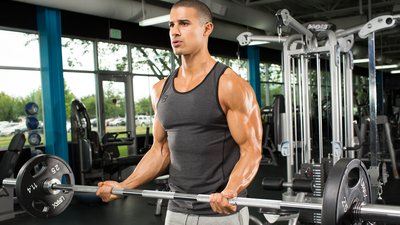"How much ya leg curl?" Chances are, nobody's ever asked you that question, and nobody ever will. But that doesn't mean isolation movements like this don't matter! On the contrary, they can be just the thing to bring up your muscle size—and even strength—where you're most lacking.
They're also some of the most versatile exercises, because you can use them countless ways: for pump-inducing burnout sets at the end of a workout, pre-exhaust work at the start, straight muscle-building volume work in the middle, and with any number of intensity-boosters.
We analyzed dozens of isolation moves to help you wade through the options and identify the best of the best. Here's our semi-authoritative guide to the 10 best single-joint moves, in no particular order.
1. Nordic Hamstring Curl
Target: Hamstrings
Why it's great: A hamstring move right off the bat? You bet, and here's why. While most programs train hip extension through the RDL, the hamstrings are actually responsible for both hip extension and knee flexion. If you're only training one movement, you're really only training half of your hamstring.
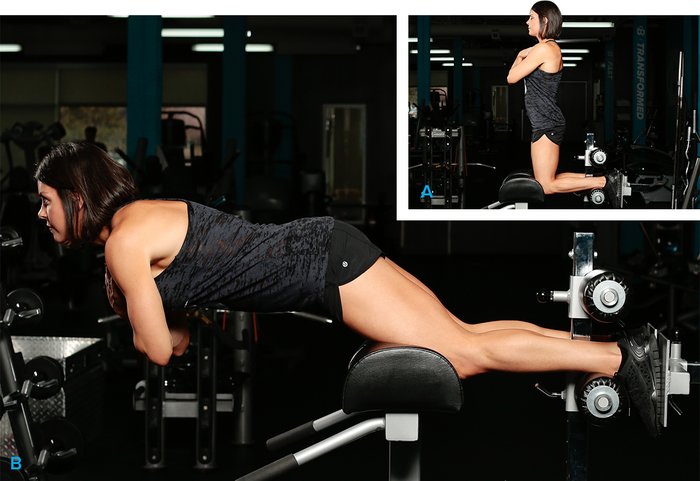
Nordic Hamstring Curl
Sure, you could just do some lying ham curls, but a 2009 study concluded the floor version (aka Russian curl, Nordic curl, or "natural" glute-ham raise) was the top single-joint hamstring movement in terms of EMG activity.[1] This doesn't mean it's an adequate replacement for, say, squats or stiff-legged deadlifts. It just means it's a perfect complement for them.
To perform them, just place a pad under your knees and hook your knees under a solid support—or even the knee pads on a lat pull-down station. But be warned: These are tough!
Training tip: Plenty of strong people can't do even one at first. If that describes you, start by just doing negatives from the top position. If you do the move on an elevated lat pull-down seat, use a dowel or broomstick to help push yourself back up.
See our top 10 movements for legs
2. Standing Barbell Curl
Target: Biceps
Why it's great: Aside from the multijoint chin-up, this is the best overall biceps exercise there is. If you go back to our previous article detailing the 10 best biceps exercises, you'll see that EMG research ranked this movement toward the middle of the pack. So why all the love here? Because while seated versions such as the preacher and concentration curl may offer a greater EMG signal, you can use a much heavier load in the standing position!
Do barbell curls first in your arm workout with challenging weights to ensure you're overloading the muscle. Restrict cheating motions to your last rep or two; if you start the movement needing momentum, the weight is simply too heavy.
Training Tip: Take a wider grip on the bar to preferentially emphasize the short (inner) head; a closer grip (hands just inside shoulder width) focuses better on the long head. But remember, emphasizing doesn't mean you're isolating one head over another. If an EZ-bar is more comfortable for your wrists or elbows, by all means use one.
3. Leg Extension
Target: Quads
Why it's great: Most leg exercises hit multiple large muscle groups, which over the course of your workout greatly increases fatigue and makes balance difficult. To zero in on the quads without having to balance yourself standing, the leg extension (misnamed because the action is technically knee extension) is often done as a final movement in your leg assault. It's also a great pre-exhaust movement to make relatively light-weight (i.e., joint-friendly) squats feel a whole lot heavier.
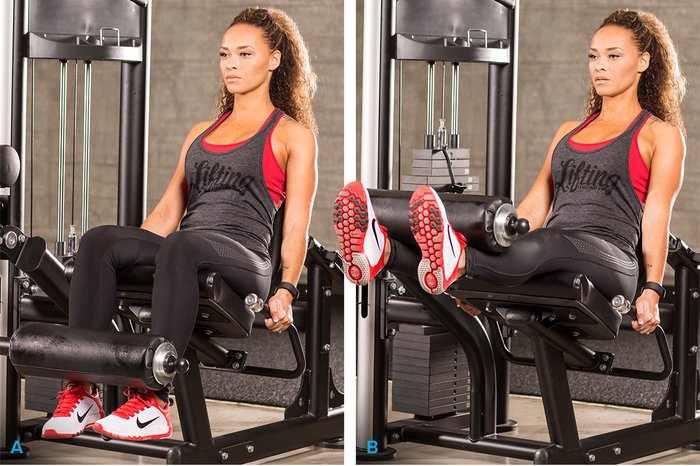
Leg Extension
What really makes the leg extension shine, though, is the way you can do all sorts of intensity-boosting techniques with it. The easiest to put into action is the classic dropset, where you reduce the poundage after reaching initial muscle failure and continuing on with the set. Then there's partials, forced reps, slow negatives—heck, this even works great with blood-flow-restriction training. Try and walk after all that!
Training Tip: The vast majority of lifters are best served by keeping their feet pointing directly forward. More advanced trainees might consider turning their feet slightly inward, which puts more stimulus on the vastus lateralis (outer quad). However, rotating the feet outward hasn't been shown to increase the load on the vastus medialis, so don't bother.[2]
4. Cable Push-Down
Target: Triceps (especially lateral and medial heads)
About This Move: There are a number of triceps moves you can choose from, but we chose the push-down because it tops the list for maximizing muscle activation of the lateral and medial triceps heads while also providing a moderate amount of emphasis on the long heads.
Like the leg extension, this move can be manipulated in many different ways including grip, body position, and the type of handle utilized. Be sure to follow progressive overload here, slowly adding weight to the stack over time. Also, don't get trigger-happy and bounce all over the place with different variations; be methodical, and stick with one version for a couple of weeks to really see growth!
Training Tip: Don't flare your elbows; that reduces tension on the triceps. Also, don't be afraid to go full-ROM and push toward lockout. Those last few inches are pure gold for triceps growth!
See our top 10 movements for triceps
5. Standing Dumbbell Lateral Raise
Target: Middle delts
Why it's great: Because it works! Raising your upper arms directly out to your sides by definition focuses on the middle delts. So just add weights and you've got a winning move!
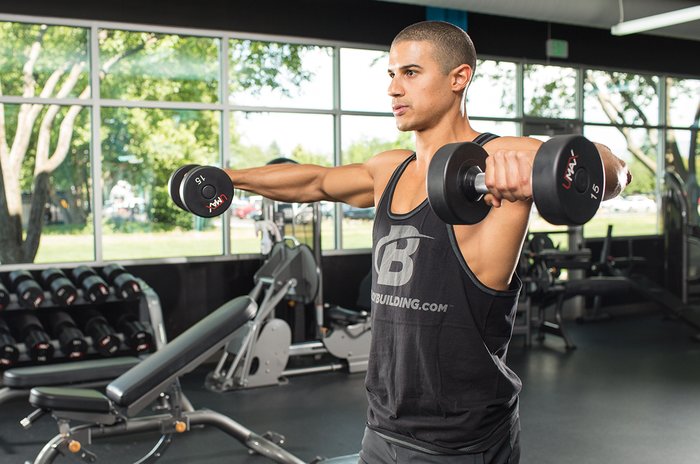
Standing Dumbbell Lateral Raise
The standing version invites a bit more body English, which allows you to go heavier than when you're doing it seated. However, don't get sloppy. Keep a slight bend in your elbows, and hold that arm position for the duration of the set. And keep those elbows up as well, because your upper arm must go straight out to your side and up for maximal middle-head contraction.
Training Tip: The best coaching cue for this is to "lead with the elbows." Still, this motion is a bit tricky for beginners to get the hang of. Rehearsing on the lateral-raise machine can give you a better idea of the body mechanics and motion before advancing to dumbbells.
See our top 10 movements for shoulders
6. Reverse Pec-Deck Fly
Target: Rear delts
Why it's great: A machine move wins for isolating the rear delts, which tend to get overlooked on shoulder day. The trick with this movement is to really feel the contraction and not just sling the weight. The machine movement edges out the free-weight rear-delt raise for two reasons:
- Muscle activation is about 10 percent higher with the machine[3]
- You can easily cheat the free-weight movement and lose the isolation effect of this single-joint move.
Training Tip: Don't limit yourself to a single grip here. Perform the reverse pec-deck fly using both the overhand and neutral (palms facing in) grip, because each recruits the rear-delt musculature slightly differently.
7. Dumbbell Fly
Target: Pecs
Why it's great: By maintaining your elbows in the slightly bent position for the duration of the set, the action is limited to the shoulder joints, making this the premiere isolation choice on chest day.
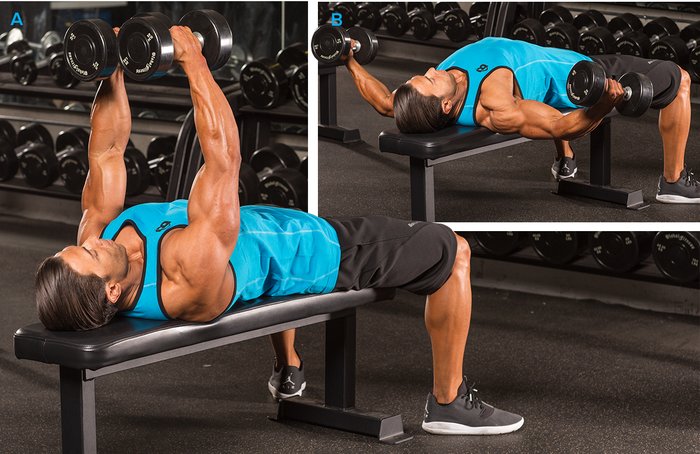
Dumbbell Fly
As with other muscle groups, once you go from multijoint to single-joint moves, the amount of weight you can lift falls substantially. Compare, for example, what you can do on flat-bench dumbbell presses versus flyes. This motion can be replicated on incline and decline benches as well, in addition to being done with cables using the lower pulley position.
Training Tip: With your arms extended, be careful not to overstretch the shoulder joints as you lower the weights. Feel a nice stretch in your pecs, but don't go any further.
See our top 10 movements for chest
8. Pec-Deck Fly
Target: Pecs
Why it's great: This is the machine version of the dumbbell fly. Why include both? Because lots of people have trouble locking in that slightly bent arm position, meaning they're still using their triceps—and are often completely unaware of it. The machine pretty much requires you to maintain the correct arm position.
Beginners can rehearse the motion here—it's akin to hugging a large tree or barrel—so they can replicate it with free weights later on. The machine version is also great for doing dropsets and partial reps to target your inner pecs.
Training Tip: Set the seat position so that your shoulders and elbows are in the same horizontal plane as your hands. Make sure to keep your elbows elevated throughout. Don't let them drop.
9. Hamstring-Curl Machine
Target: Hamstrings
Why it's great: Leg exercises are commonly divided into squat-like moves (squats, pistols, lunges, etc.) and isolation moves (calf raises, leg extensions, hamstring curls, etc.). Both have their place, and in the latter case, machines can really help isolate muscle groups as a result of the fixed movement planes.
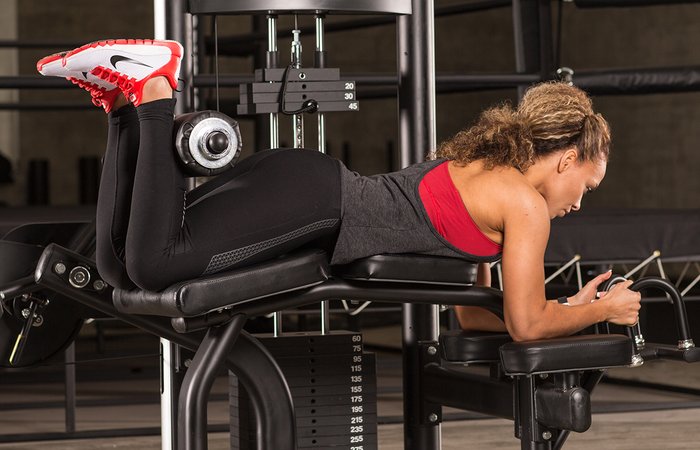
Hamstring-Curl Machine
Why not just limit ourselves to the Nordic or natural variation explained earlier? Try a few reps and see why. On the other hand, machine hamstring curls can be done by anyone, but they're still an absolutely brutal single-joint exercise that should be a staple on leg day. While they ensure high levels of muscle activation, they also allow you to get a wicked pump by using high-level strategies like forced reps, dropsets, and rest-pause training.[1]
Training Tip: Once your heavy working sets of leg work are done, plug these in. They complement Romanian deadlifts, which move around the hip joint, not the knee.
10. Straight-Arm Pull-Down
Target: Lats
Why it's great: This is one of those moves that, if done right, will absolutely fry your lats. Start with a light weight, and really focus on squeezing your scapulae down and flat across your back while cinching down on your lats. Emphasize the eccentric, and slowly allow the bar to raise back up in front of you to a full overhead stretch.
While we don't have any EMG to back this exercise, give it a shot and you'll see what a wicked pump it gives you.
Training Tip: Rather than standing completely vertical, take a couple steps back from the pulley and work with a slight torso lean to get a good, long stretch. Sure, you won't be able to pull big weight like you can in the bent-arm lat pull-down, but you don't need much weight to see considerable benefit here.
See our top 10 movements for back
References
- Ebben, W. P. (2009). Hamstring activation during lower body resistance training exercises. International Journal of Sports Physiology and Performance, 4(1), 84-96.
- Signorile, J. F., Lew, K. M., Stoutenberg, M., Pluchino, A., Lewis, J. E., & Gao, J. (2014). Range of motion and leg rotation affect electromyography activation levels of the superficial quadriceps muscles during leg extension. The Journal of Strength & Conditioning Research, 28(9), 2536-2545.
- Boeckh-Behrens, W. U., Beier, P., & Buskies, W. (2001). Fitness Strength Training: The Best Exercises and Methods for Sport and Health. Rowohlt-Taschenbuch-Verlag.

